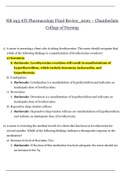Exam (elaborations)
NR 293 ATI Pharmacology Final Review_2020 | NR293 ATI Pharmacology Final Review_2020 – Graded A
- Course
- ATI Pharmacology (NR293)
- Institution
- Chamberlain College Of Nursing
NR 293 ATI Pharmacology Final Review_2020 – Chamberlain College of Nursing 1) A nurse is assessing a client who is taking levothyroxine. The nurse should recognize that which of the following findings is a manifestation of levothyroxine overdose? a) Insomnia i) Rationale: Levothyroxine overd...
[Show more]



